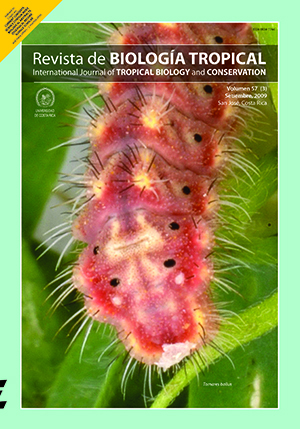Abstract
Onychophoran worms are terrestrial organisms that have changed relatively little since the mid-Cambrian.We collected Macroperipatus geagy in coffee plantations at “Hacienda El Roble”, Santander, Colombia, and here redescribe the species based on 15 individuals. A digital three-dimensional reconstruction of the ventral side of the body indicates that the primary and accessory papillae lack a defined distribution pattern. Diagnostic characters: one main tooth and one accessory tooth in the outer jaw, and one main tooth, one accessory tooth and seven denticles in the internal jaw. Measurements: length (X=45.66 mm; SD=26.10), weight (X= 0.95 g; SD= 2.21) and number of lobopods (X= 28.13 pairs; SD= 1.30). We present a taxonomic key for six species of Macroperipatus. The liquid adhesive secretion lost 60% of the initial weight at 70 oC (solid: 13% close to 90 oC). The stability phase of the liquid secretion was within 90-280 oC (100 oC -205 oC in the solid secretion). The starting degradation temperature of the sample was 355 oC. Heat flow changes in the solid and liquid secretions were confirmed by the sample behavior during thermogravimetric analysis. The percentage of β sheets calcu-lated by infrared spectrum was 59%. In comparison with Nephila spiders, the onychophoran secretion lost more weight and entered the phase of degradation at lower temperatures. This secondary structure of proteins gives the onychophoran adhesive secretion a tensile strength and extensibility similar to those of the silk produced by spiders for prey-capture.
##plugins.facebook.comentarios##

This work is licensed under a Creative Commons Attribution 4.0 International License.
Copyright (c) 2009 Revista de Biología Tropical






